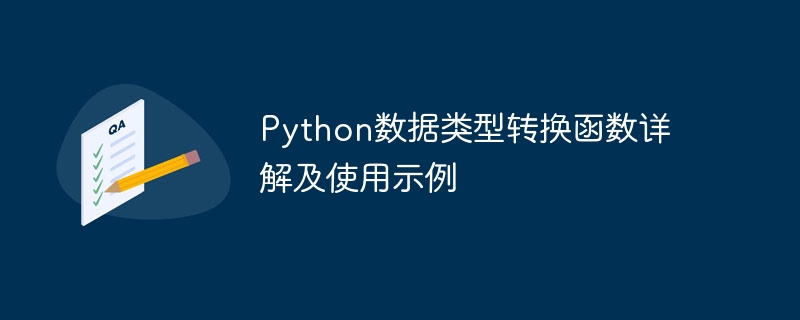

Detailed explanation of Python data type conversion function and usage examples
In Python programming, data type conversion is a very common operation. When we deal with different types of data, we need to convert it into the appropriate type for manipulation or comparison. Python provides a series of data type conversion functions that can easily convert between data types. This article will introduce various data type conversion functions in Python in detail and provide usage examples.
Example 1: Convert a number to an integer type
num = 10.5 num_int = int(num) print(num_int) # 输出:10
Example 2: Convert a string to an integer type
str_num = "20" str_num_int = int(str_num) print(str_num_int) # 输出:20
Example 1: Convert a number to a floating point type
num_int = 10 num_float = float(num_int) print(num_float) # 输出:10.0
Example 2: Convert a string to a floating point type
str_num = "3.14" str_num_float = float(str_num) print(str_num_float) # 输出:3.14
Example 1: Convert integer to string
num_int = 10 num_str = str(num_int) print(num_str) # 输出:"10"
Example 2: Convert floating point to string
num_float = 3.14 num_str = str(num_float) print(num_str) # 输出:"3.14"
Example 1: Convert integer to Boolean value
num_int = 0 num_bool = bool(num_int) print(num_bool) # 输出:False
Example 2: Convert string to Boolean value
str_empty = "" str_bool = bool(str_empty) print(str_bool) # 输出:False str_nonempty = "nonempty" str_bool = bool(str_nonempty) print(str_bool) # 输出:True
Example 1: Convert string to list
str_word = "hello" str_list = list(str_word) print(str_list) # 输出:['h', 'e', 'l', 'l', 'o']
Example 2: Convert tuple to list
tuple_nums = (1, 2, 3) tuple_list = list(tuple_nums) print(tuple_list) # 输出:[1, 2, 3]
list_nums = [1, 2, 3] list_tuple = tuple(list_nums) print(list_tuple) # 输出:(1, 2, 3)
str_word = "hello"
str_tuple = tuple(str_word)
print(str_tuple) # 输出:('h', 'e', 'l', 'l', 'o')list_nums = [1, 2, 2, 3, 3, 3]
list_set = set(list_nums)
print(list_set) # 输出:{1, 2, 3}Example 2: Convert a string to a set
str_word = "hello"
str_set = set(str_word)
print(str_set) # 输出:{'e', 'o', 'l', 'h'}Through the introduction of this article, we have learned about Python Common data type conversion functions and usage examples are provided. In actual programming, by using these functions flexibly as needed, conversion between different data types can be easily achieved.
The above is the detailed content of An in-depth analysis of Python's data type conversion functions and usage examples. For more information, please follow other related articles on the PHP Chinese website!
 How to make charts and data analysis charts in PPT
How to make charts and data analysis charts in PPT
 Android voice playback function implementation method
Android voice playback function implementation method
 AC contactor use
AC contactor use
 The difference between vscode and visual studio
The difference between vscode and visual studio
 The difference between Java and Java
The difference between Java and Java
 Introduction to hard disk interface types
Introduction to hard disk interface types
 nagios configuration method
nagios configuration method
 How to delete a folder in linux
How to delete a folder in linux




